December 8, 2013 Auroras
Highway 38 North of Grand Rapids, MN
Bah, Humbug! The magnetic field was dropping south, and I was stuck at a Christmas party with my co-workers. The corotating interaction region ahead of a coronal hole high speed stream was affecting Earth, and I knew the auroras would be out shortly. I stayed as long as I could and occasionally popped my head outside to have a look to see if the auroras had appeared yet. The magnetic field was south to near -20 nT, but it was taking a while for the auroras to appear (thank goodness-- I didn't want to be a dork and leave the party too early).
Just before 11:00, the green band of auroras grew higher above the northern horizon, and it looked like a substorm would be underway soon, so I picked that time to leave. I drove north on Highway 38, unsure of my shooting location. When I got to Gunn Park north of town, the substorm started, so I stopped to take a photo.
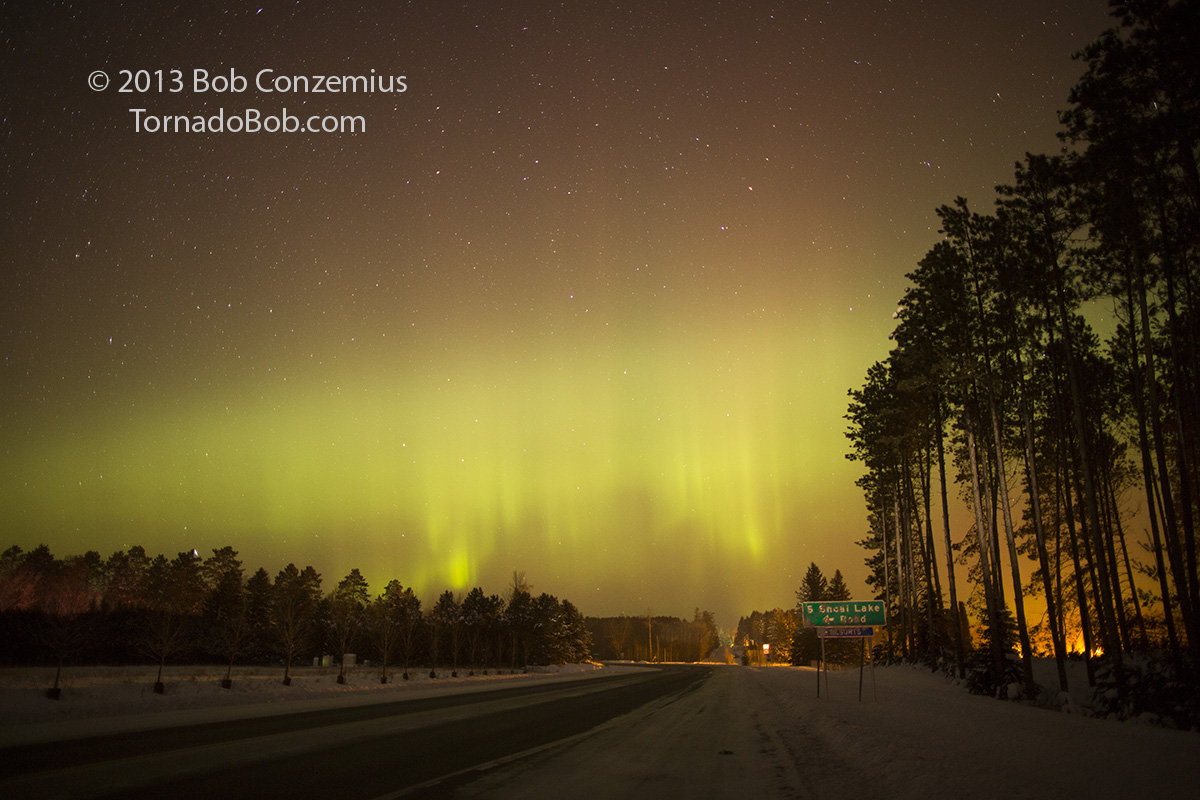 |
| Auroras at Gunn Park. |
I needed to go find a location as soon as possible, or else I'd miss the photography opportunities provided by this substorm. It had snowed a lot during the past few days, so I wanted a location where I could get snowy conifers in the foreground and auroras in the background. I had to get at least a few miles north of town because the plume from the nearby power plant was draped across the areas just north of Grand Rapids. That meant I probably had to go to somewhere near the Chippewa National Forest Boundary. In that area, I had shot at two locations in the past. One was the former (now closed) Wilderness Pub parking lot, which is not the most scenic because it looks over a couple buildings. However, it occurred to me that I could probably walk into the bog north of there and see snow-covered black spruce trees that were short enough not to cover up the background, so up to the Wilderness Pub I drove. When I got there, some nicely structured auroral curtains were raging. I had to snap this picture as quickly as I could.
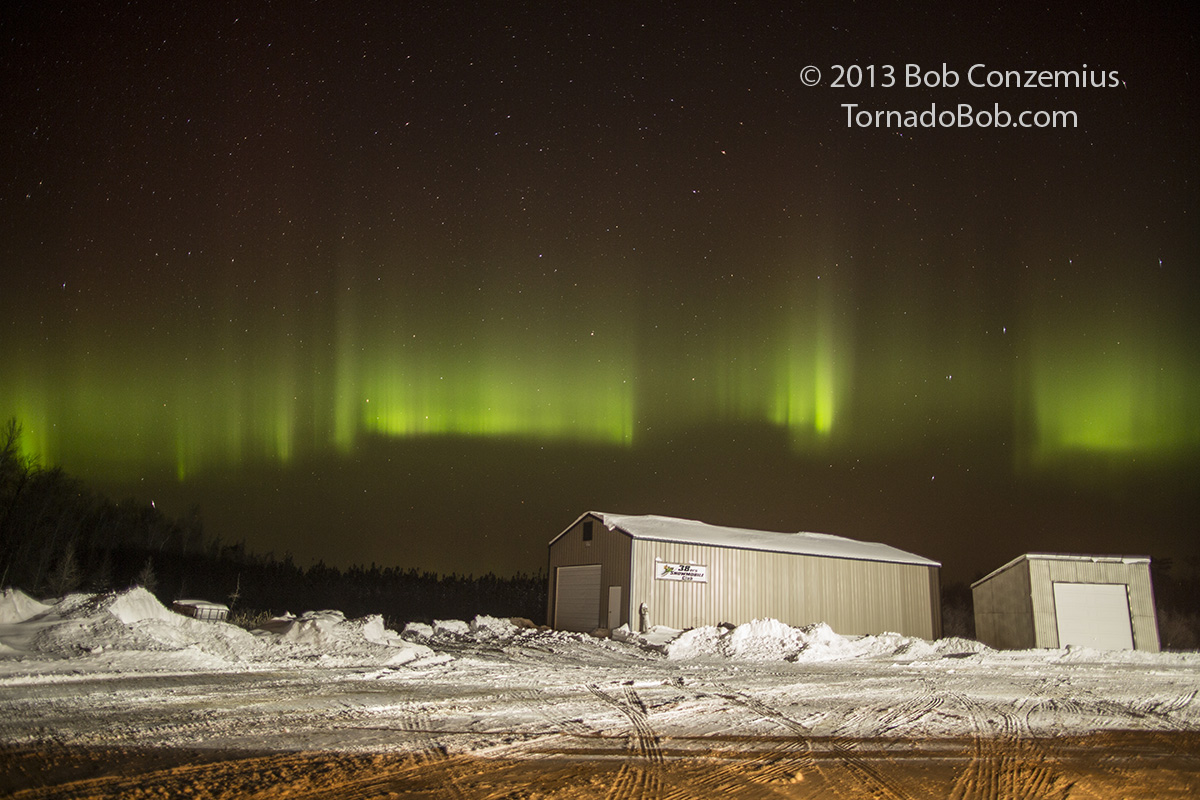 |
| Nice columnar auroras behind the former Wilderness Pub on Highway 38. |
I walked past the buildings, on the snowmobile trail, into the bog and started taking a bit more time setting up the right shots. The trail had not been groomed yet, and there were really no riders out, so it was very quiet. The substorm was starting to subside a little.
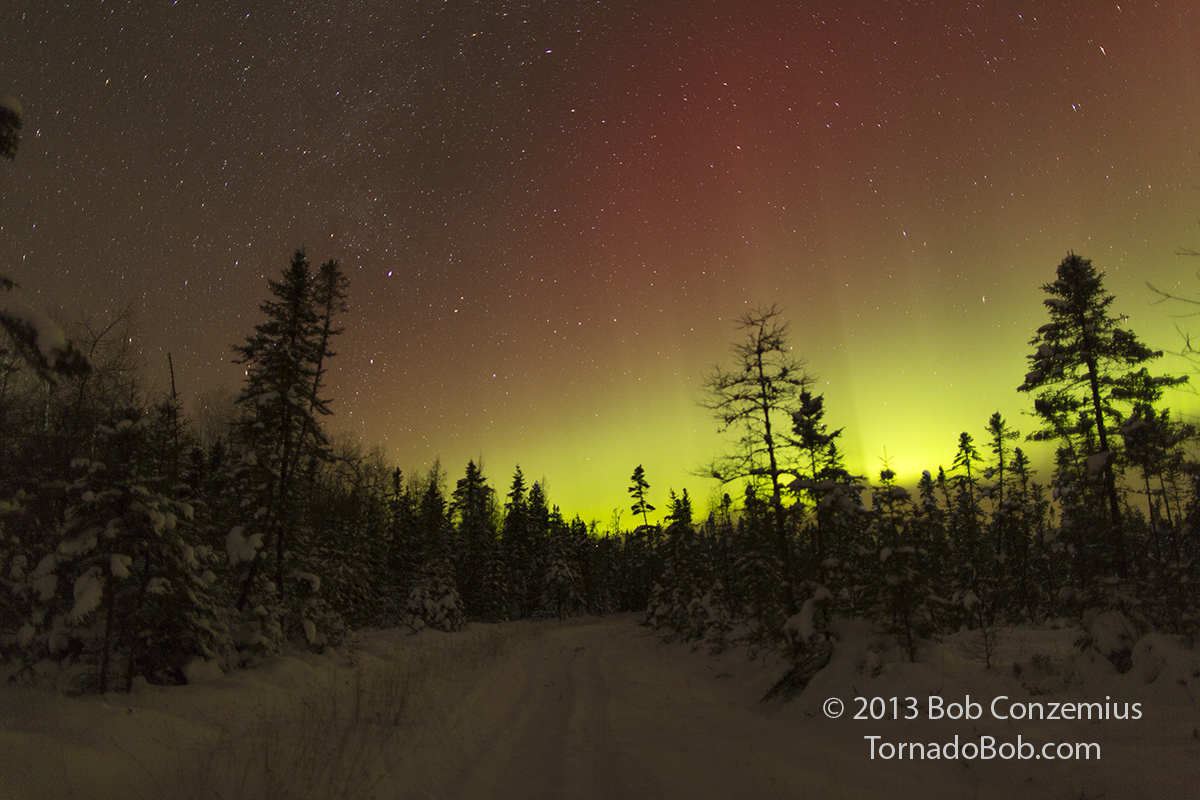 |
| On the Suomi Snowmobile Trail behind the Wilderness Pub. |
I stepped off the trail and into knee-deep snow, checking to make sure I was not sinking into water. These bogs are often the last things to freeze up in winter, and the fresh snow can insulate them from freezing, so you can end up getting rather wet if you are not careful. This would not be a good thing on a night like tonight, because the air temperature had already dropped into the -20s F (-30s C).
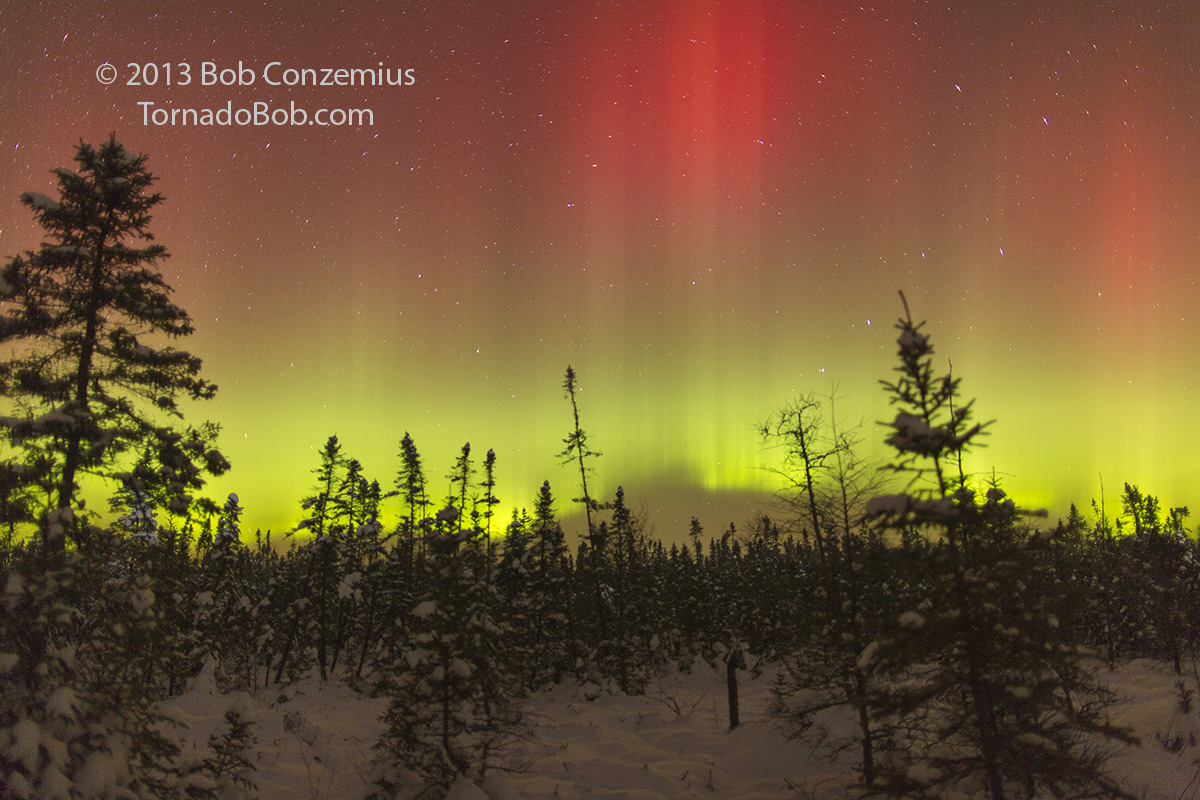 |
| I took a few steps off the trail into the bog to get this shot. |
I also tried some light painting with my LED flashlight to bring out the foreground a bit more.
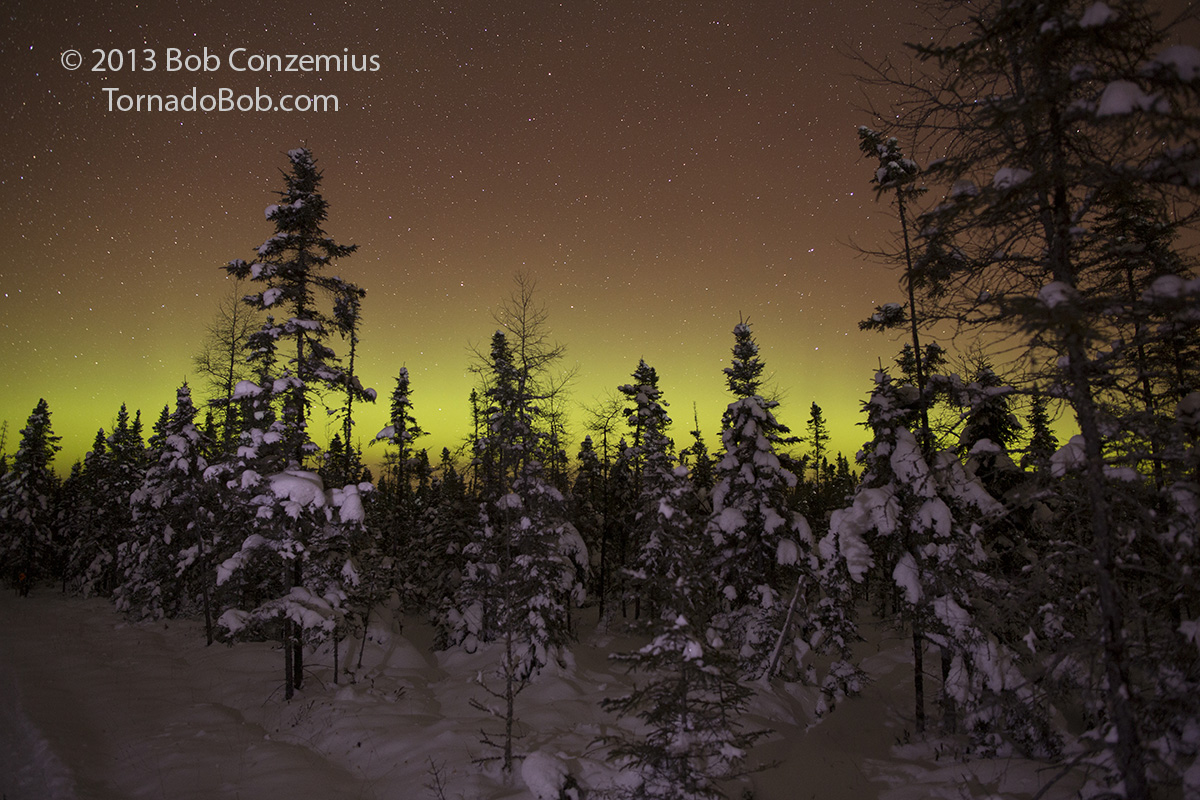 |
| Back on the snowmobile trail, trying to paint the foreground with a little light. |
I also set up a camera with the f2.8 16-35mm wide angle lens. The auroras were fading to the horizon now, so I thought I'd bring out the stars and Milky Way a bit more. The longer exposure times (30 seconds) allowed the auroral glow to reflect off the snow a little. I also caught a meteor in one of my images.
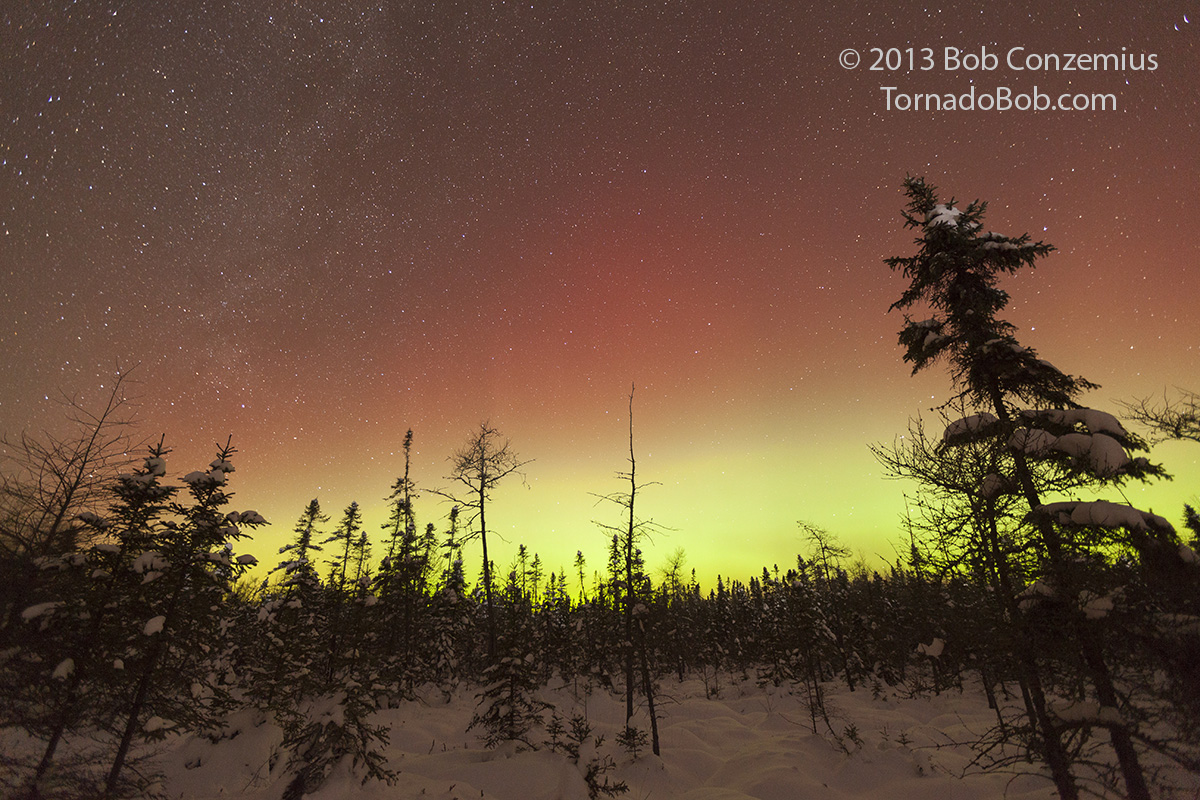 |
| Shot at 16mm, f2.8 to get both the Milky Way and the auroras. |
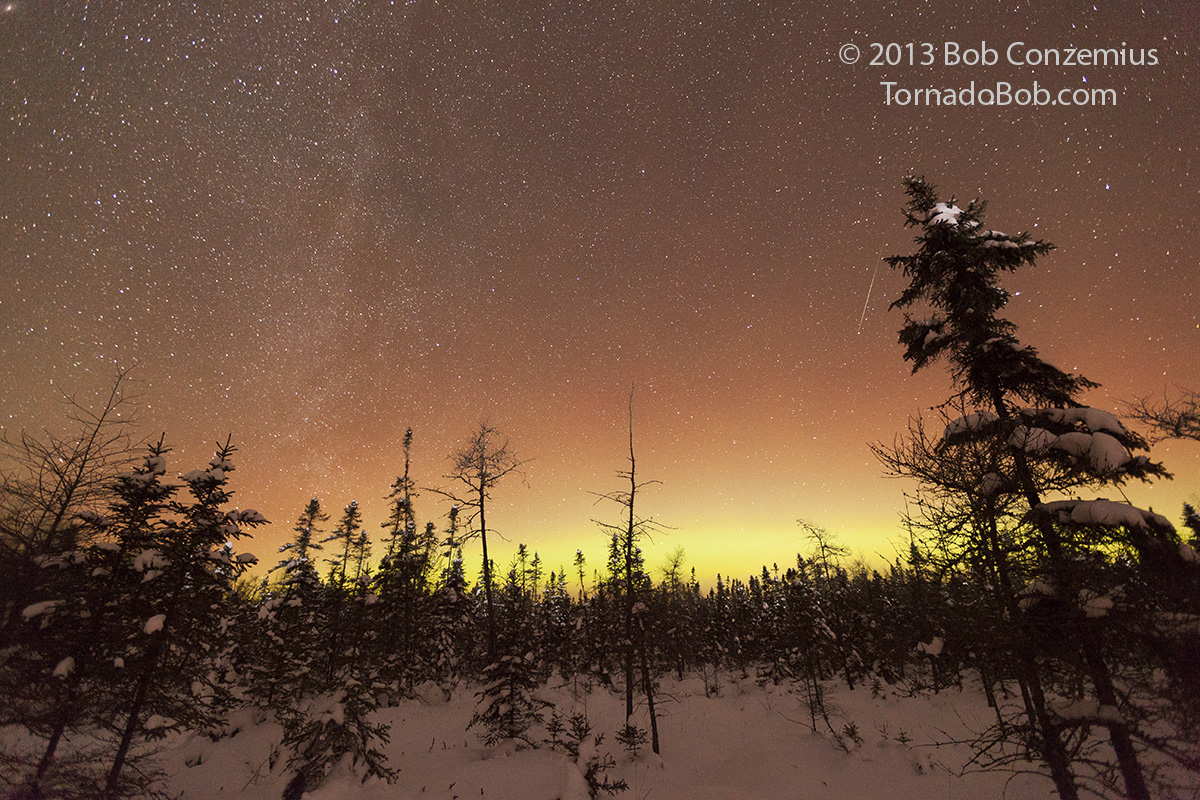 |
| Same wide shot, a few minutes later, with a meteor. |
After a while, having gotten some images with snow-covered trees, I decided to try a more traditional lake location with a northern view. I drove up to Pughole Lake, but the boat landing was not plowed, and my Jetta would certainly get stuck there, so I tried the Suomi Hills ski area on Orange Lake Road. The auroras were too low in the sky to be visible from there, and I didn't feel like going onto Orange Lake. I had already been there before, and there would be a lot of slush on the ice. I did not want to freeze my tripod onto the lake surface.
I left Orange Lake Road thinking I might be done, but the auroral oval started to brighten up again. I remembered that I had not been to that public landing on Johnson Lake before. I decided to try that one.
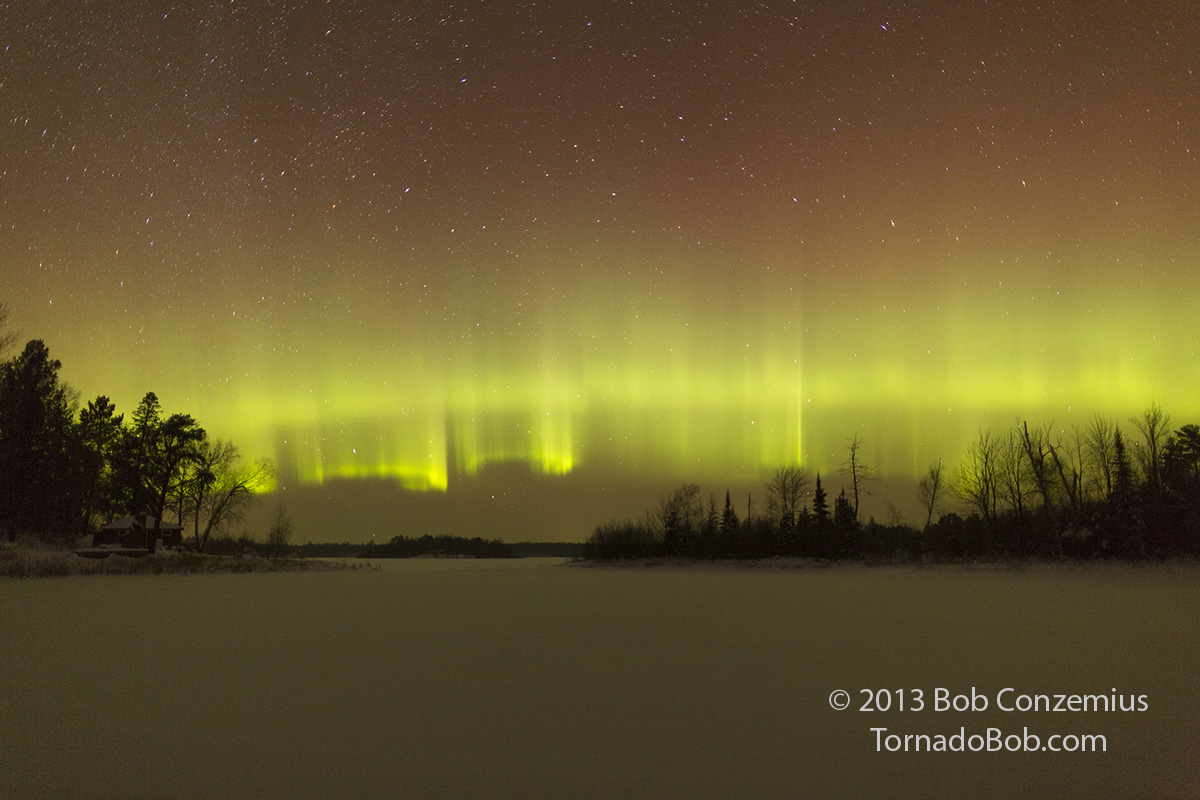 |
| 24mm f1.4 at Johnson Lake. |
Shortly after I arrived, the second substorm of the evening ensued. For some reason, the first substorm is always the best, and the later ones are a little mellower. That's good for people who like to see auroras but don't want to stay up past midnight. The best substorms seem to happen most often around 10 or 11 pm. I still enjoyed watching this show from Johnson Lake as the temperatures dropped into the negative lower 30s F (around -35 or -36 C)
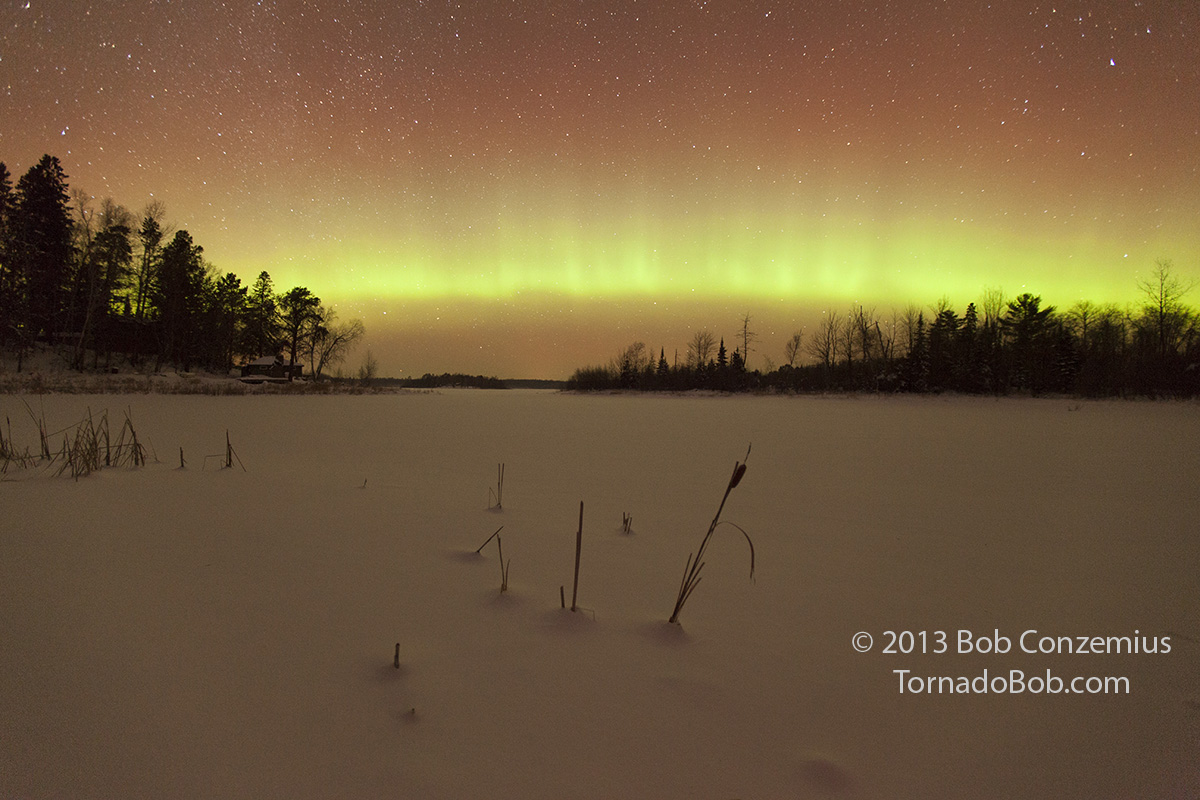 |
| Cattails and auroras on Johnson Lake (temperature near -30 deg F.) |
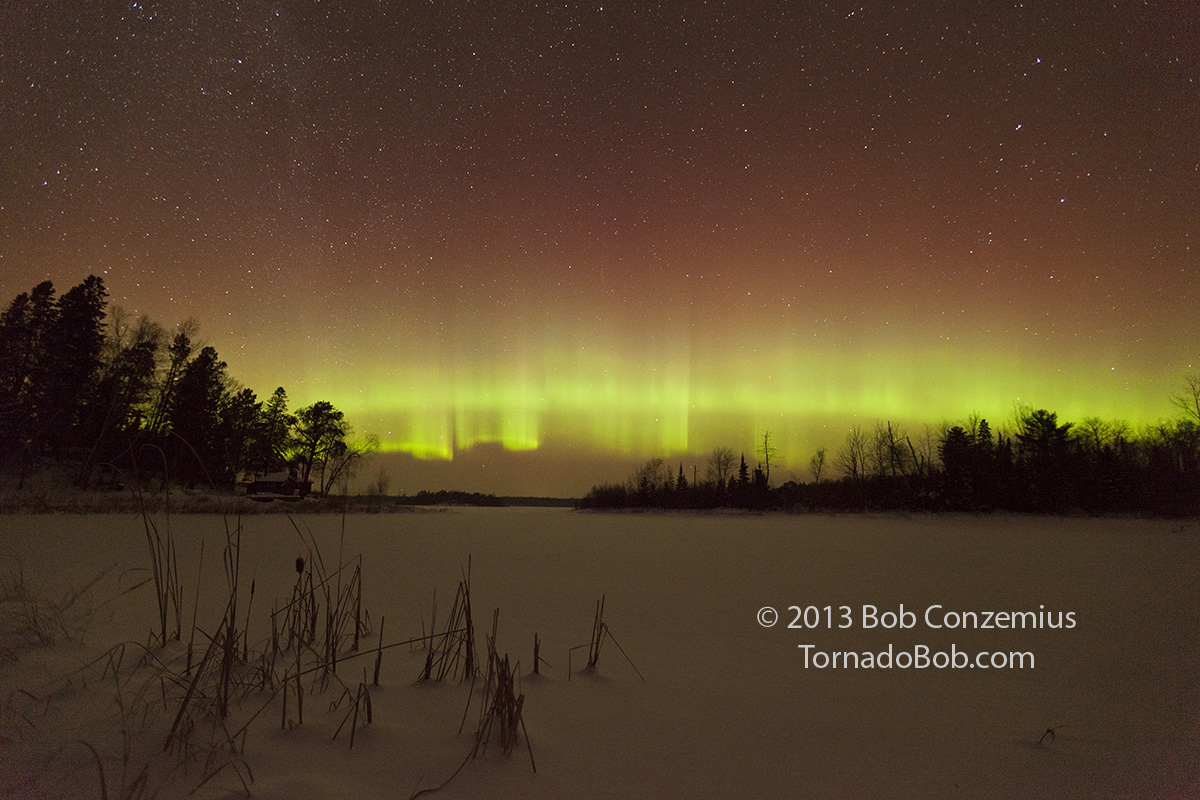 |
| Another 16mm shot with cattails and auroras. |
After an hour or so of shooting at Johnson Lake, one of my cameras died (cold battery). I shot a few more images with the other camera, but the auroras were starting to fade, so I called it a night. I drove home with -33 F on the car thermometer (-36 C) and managed to find -35 deg F in a bog on the north side of Grand Rapids on the way home.
 |
| UV image of the sun showing the coronal hole (the dark spot in the middle) a couple days earlier, when it was pointing at Earth. |
The value below shows the value of the magnetic field at the ACE (Advanced Composition Explorer) spacecraft at the L1 point, where there is equal gravitational pull from the Earth and sun. It gives us about an hour advance notice of what solar wind will do with Earth's magnetic field. A sharply southward (less than -10 nT) interplanetary magnetic field (IMF) almost always brings auroras to northern Minnesota. It dropped to near -25 nT briefly around 8:30 in the evening (0230 UTC). By 9:55 (0355 UTC), the auroral oval had climbed high enough into the sky that we could see it in town. Bz had gone north by then, but the southward excursion was enough to get things started, and we continued to have auroras the rest of the night. Bz went back south to near -10 nT just before midnight, and that, along with an abrupt increase in speed (to 600 km/s) at 0730 UTC helped reinvigorate the auroras after midnight.
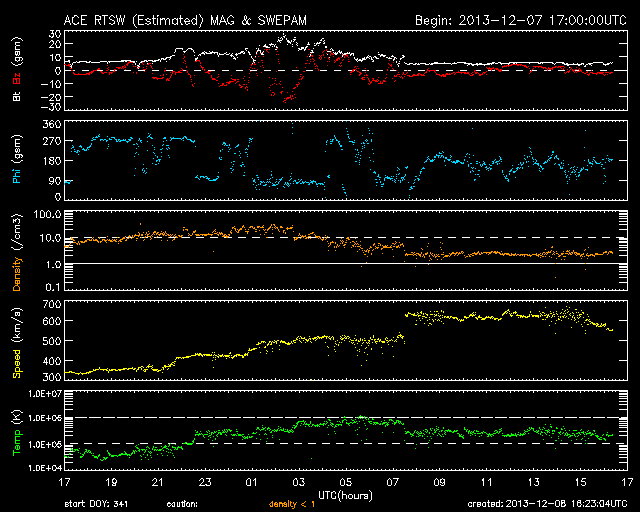 |
| The magnetic field measured by the ACE spacecraft shows values down to near -25 nT. |
The Kp index is compiled from various magnetometer readings around Earth. Most directly, it is a measure of the fluctuation in the magnetic field at a given location. The total magnetic field is composed of the Earth's own magnetic field plus whatever more rapid variations occur due to interactions with the solar wind. It is not a direct measurement of auroral activity, although auroras are a lot more likely to occur when the Kp index is high. I've seen auroras in Minnesota down to Kp=1, but you have to look really carefully along the northern horizon on a moon-free night to see those. I've also looked on nights with Kp=5 and seen nothing. Overall, the best predictor for auroras is the IMF Bz (red line in the previous figure). When it's -10 nT or below, it's nighttime, and the skies are clear, look for auroras in northern Minnesota because they'll almost certainly be there.
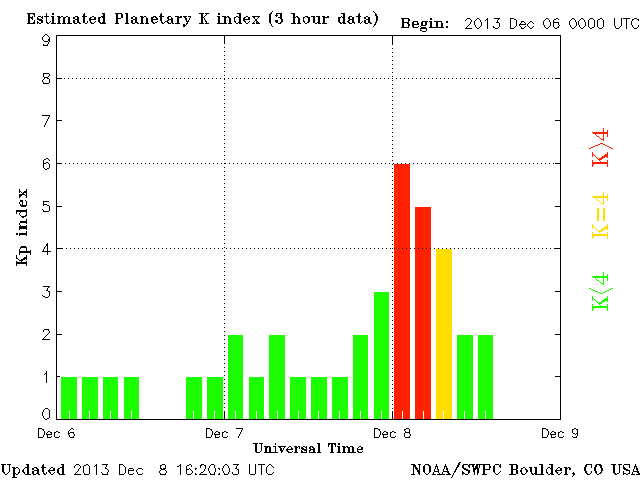 |
| The Kp index reached a value of 6 for this event-- a moderate (G2) geomagnetic storm. |
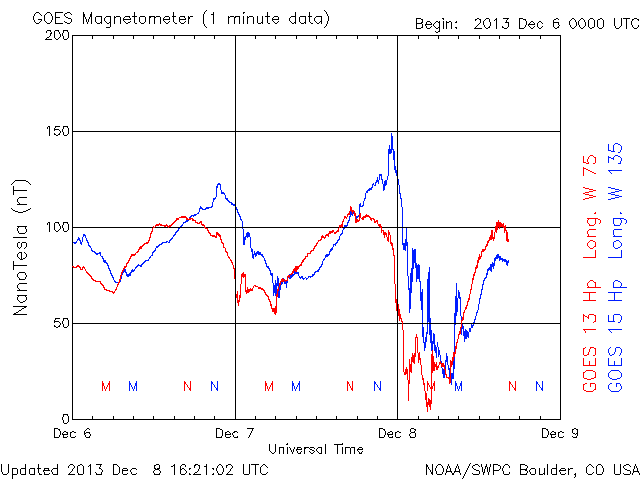 |
| GOES magnetometer data less than 50 nT usually means visible auroras in Minnesota. |
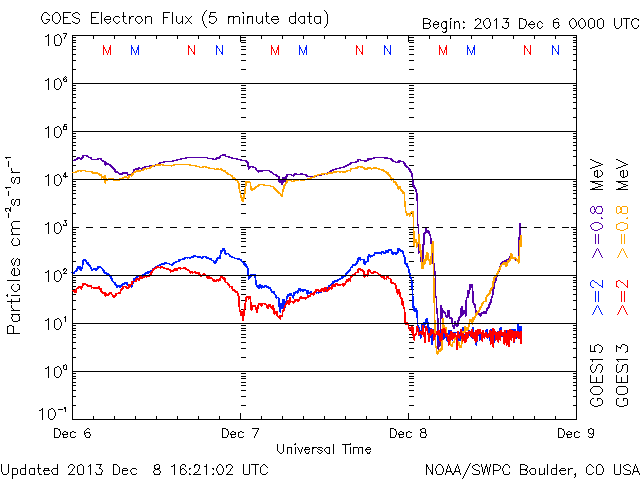 |
| Electron flux drops. |
Back to Auroras | Home



